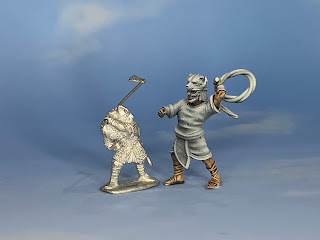How Big !
There is nothing wrong with this game with 6mm or 15mm chariots, especially if you want to play it on a kitchen table or something similar.
However, I just feel like the chariot races would have been an epic spectacle. The roaring crowds, the thunder of hooves, the cracking of whips, and I'm just not feeling that with these smaller scales.
I want this to have more of a WOW factor. I also want this to feel more like Roman chariot racing, think Ben-Hur and you'll know where I'm going with this.
With this in mind, I am inbigulating everything.
Here we have a regular Gripping Beast 28mm Dark-Age figure next to One of my oversized Charioteers. This is how big we are going.
Once established in Rome, chariot racing became highly factionalised with charioteers racing for one of four coloured teams: the Reds, Blues, Greens and Whites.
A four-chariot race was called a certamina singularum, an eight-chariot race was called a certamina binarum, and a twelve-chariot race was called a certamina ternarum. Each faction was represented in each race with either one, two or three teams.
Chariots were four-horse vehicles with a single driver.
I think I will stick to a maximum of eight chariots, or at least to start with as I plan to build both chariots and wrecked chariots for each model.
With the first chariot printed, it was time to get some paint down. Being very conscious of the fact that this is potentially a huge build I want to limit my time spent painting the models.
Running some quick numbers, using my previous Colosseum build as a guide I think I will probably need around 400 or so figures just to represent the crowd. I plan to make the crowd a little more spread out for this and also plan to add a few more varieties of models. I will need to modify some of the supporters to show which of the four coloured teams they support.
First up was a three-stage undercoat ranging from black through grey to finally a white zenithal spray.
For the most part, I used a combination of contrast paints and washes with a very light dry brush. The metal parts were picked out in a very dark metallic paint. To help differentiate the teams within one coloured faction I plan to use different coloured horses. For example, a red chariot with white horses, a red chariot with black horses etc. To add a little more variety, I will also use different charioteers where I can, although that is less of a necessity.
I have gone with 10cm x 10cm laser-cut wooden bases. I will keep that as a standard size for all the chariots and their crashed alternatives.
I have plans to do some unruly supporters that can be used for inevitable 'Pitch Invasions' which during the actual game become rather irritating obstacles that need to be navigated around.




























